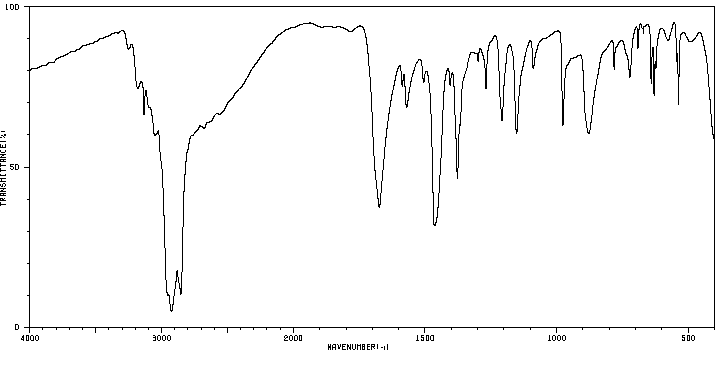(1H)-Imidazo<4,5-d>pyriddazine-4(5H)-one | 28682-94-2
中文名称
——
中文别名
——
英文名称
(1H)-Imidazo<4,5-d>pyriddazine-4(5H)-one
英文别名
2-aza-3-deazahypoxanthine;imidazo<4,5-d>pyridazine-4-one;imidazo[4,5-d]pyridazin-4-one;imidazo[4,5-d]pyridazine;1H-4,5-Dihydro-imidazo<4,5-d>pyridazon-(4);1,5-dihydro-imidazo[4,5-d]pyridazin-4-one;1,5-Dihydro-imidazo[4,5-d]pyridazin-4-on;1H-Imidazo[4,5-d]pyridazin-7-ol;3,6-dihydroimidazo[4,5-d]pyridazin-7-one
CAS
28682-94-2
化学式
C5H4N4O
mdl
MFCD11557171
分子量
136.113
InChiKey
DSZCQHJBMSIMNX-UHFFFAOYSA-N
BEILSTEIN
——
EINECS
——
-
物化性质
-
计算性质
-
ADMET
-
安全信息
-
SDS
-
制备方法与用途
-
上下游信息
-
文献信息
-
表征谱图
-
同类化合物
-
相关功能分类
-
相关结构分类
物化性质
-
熔点:>300 °C
-
密度:1.89±0.1 g/cm3(Predicted)
计算性质
-
辛醇/水分配系数(LogP):-0.5
-
重原子数:10
-
可旋转键数:0
-
环数:2.0
-
sp3杂化的碳原子比例:0.0
-
拓扑面积:70.1
-
氢给体数:2
-
氢受体数:3
SDS
反应信息
-
作为反应物:描述:(1H)-Imidazo<4,5-d>pyriddazine-4(5H)-one 在 三氟甲磺酸三甲基硅酯 、 氨 、 1,8-二氮杂双环[5.4.0]十一碳-7-烯 、 N,N-二乙基苯胺 、 三氯氧磷 作用下, 以 甲醇 、 乙腈 为溶剂, 反应 27.0h, 生成 4-amino-1-(2-C-methyl-β-D-ribofuranosyl)imidazo[4,5-d]pyridazine参考文献:名称:2'-C-甲基-β-D-呋喃基咪唑[4,5-D]哒嗪衍生物(2-AZA-3-脱氮杂嘌呤核苷类似物)的合成摘要:为了评价它们的抗病毒特性,已经合成了两种咪唑并[4,5-d]哒嗪2-C-甲基-β-D-呋喃核苷衍生物。DOI:10.1081/ncn-200060225
-
作为产物:描述:Methyl 1-<(benzyloxy)methyl>-5-(1,3-dioxolan-2-yl)-2-(phenylthio)imidazole-4-carboxylate 在 盐酸 、 aluminum amalgam 、 肼 作用下, 以 乙醇 、 丙酮 为溶剂, 反应 24.5h, 生成 (1H)-Imidazo<4,5-d>pyriddazine-4(5H)-one参考文献:名称:Multifunctionalization of imidazole via sequential halogen-metal exchange: a new route to purine-ring analogs摘要:A new method for the synthesis of purine-ring analogs based upon the sequential halogen-metal exchange functionalization of 1-[(benzyloxy)methyl]-2,4,5-triiodoimidazole (1) has been developed and is illustrated by the synthesis of (1H)-imidazo[4,5-d]pyridazin-4(5H)-one (2-aza-3-deazahypoxanthine, 8). Treatment of 1 with BuLi followed by quench with PhSSPh afforded the 2-(phenylthio) derivative, which upon treatment with BuLi followed by quench with DMF gave the 5-carboxaldehyde. This aldehyde was converted into its ethylene acetal, which was treated with BuLi followed by quench with ClCO2CH3 to afford a 4-(methoxycarbonyl)imidazole. Removal of the phenylthio group with Al(Hg) and the (benzyloxy)methyl and ethylene acetal protecting groups concomitantly with 3 M HCl afforded methyl 5(4)-formylimidazole-4(5)-carboxylate, which underwent cyclo-condensation with ethanolic NH2NH2 to give target 8. This synthetic approach was found amenable to modification by efficient ''one-pot'' multistep transformations. Thus, treatment of 1 with (a) BuLi, (b) (CH3)3SiCl, (c) BuLi, (d) (CH3)2NN(CH3)CHO, (e) BuLi, and (f) (CH3OCO)2O afforded the N-protected 4-(methoxycarbonyl)-imidazole-5-carboxaldehyde (13) in 25% yield directly from 1. Imidazole 13 was then elaborated to 8 in two steps. 1-Formyl-1,2,2-trimethylhydrazine is a recommended replacement for DMF as a tandem formylating/ortho-metalation directing agent.DOI:10.1021/jo00040a011
文献信息
-
Purine nucleoside analogues for treating flaviviridae including hepatitis C申请人:Idenix Pharmaceuticals, Inc.公开号:US09186369B2公开(公告)日:2015-11-17This invention is directed to a method for treating a host, especially a human, infected with hepatitis C, flavivirus and/or pestivirus, comprising administering to that host an effective amount of an anti-HCV biologically active pentofuranonucleoside where the pentofuranonucleoside base is an optionally substituted 2-azapurine. The optionally substituted pentofuranonucleoside, or a salt or prodrug thereof, may be administered alone or in combination with one or more optionally substituted pentofuranonucleosides or other anti-viral agents.
-
[EN] GAMMA SECRETASE MODULATORS<br/>[FR] MODULATEURS DE GAMMA SÉCRÉTASE申请人:SCHERING CORP公开号:WO2009076352A1公开(公告)日:2009-06-18This invention provides novel compounds that are modulators of gamma secretase. The compounds have the formula [Chemical formula should be inserted here as it appears on abstract in electronic form.] Also disclosed are methods of modulating gamma secretase activity and methods of treating Alzheimer's disease using the compounds of formula (I).
-
The Preparation of Several 4-Substituted Imidazo[4,5-d]pyridazines as Possible Purine Antimetabolites作者:John A. CarbonDOI:10.1021/ja01555a047日期:1958.11
表征谱图
-
氢谱1HNMR
-
质谱MS
-
碳谱13CNMR
-
红外IR
-
拉曼Raman
-
峰位数据
-
峰位匹配
-
表征信息
同类化合物
(S)-3-(2-(二氟甲基)吡啶-4-基)-7-氟-3-(3-(嘧啶-5-基)苯基)-3H-异吲哚-1-胺
(6-羟基嘧啶-4-基)乙酸
(4,5-二甲氧基-1,2,3,6-四氢哒嗪)
鲁匹替丁
马西替坦杂质7
马西替坦杂质4
马西替坦杂质
马西替坦原料药杂质D
马西替坦原料药杂质B
马西替坦
顺式-4-{[5-溴-2-(2,5-二甲基-1H-吡咯-1-基)-6-甲基嘧啶-4-基]氨基}环己醇
非沙比妥
非巴氨酯
非尼啶醇
青鲜素钾盐
雷特格韦钾盐
雷特格韦相关化合物E(USP)
雷特格韦杂质8
雷特格韦EP杂质H
雷特格韦-RT9
雷特格韦
阿西莫司杂质3
阿西莫司
阿脲四水合物
阿脲一水合物
阿维霉素
阿米美啶
阿米洛利
阿米妥钠
阿洛巴比妥
阿普瑞西他滨
阿普比妥
阿巴卡韦相关化合物B(USP)
阿卡明
阿伐那非杂质V
阿伐那非杂质1
阿伐那非杂质
阿伐那非中间体
阿伐那非
铂(2+)二氯化6-甲基-1,3-二{2-[(2-甲基丙基)硫烷基]乙基}嘧啶-2,4(1H,3H)-二酮(1:1)
钴1,2,3,6-四氢-2,6-二氧代嘧啶-4-羧酸酯(1:2)
钠5-烯丙基-4,6-二氧代-1,4,5,6-四氢-2-嘧啶醇酸酯
钠5-乙基-4,6-二氧代-1,4,5,6-四氢-2-嘧啶醇酸酯
钠5-(2-溴丙-2-烯基)-5-丁烷-2-基-4,6-二氧代-1H-嘧啶-2-醇
醌肟腙
酒石酸噻吩嘧啶
那可比妥
辛基2,6-二氧代-1,2,3,6-四氢-4-嘧啶羧酸酯
赛乐西帕杂质3
赛乐西帕KSM3








